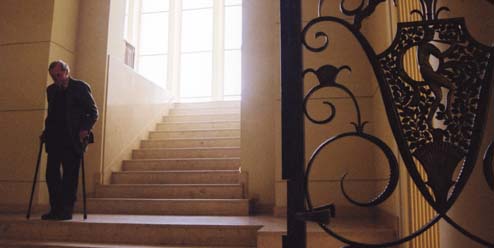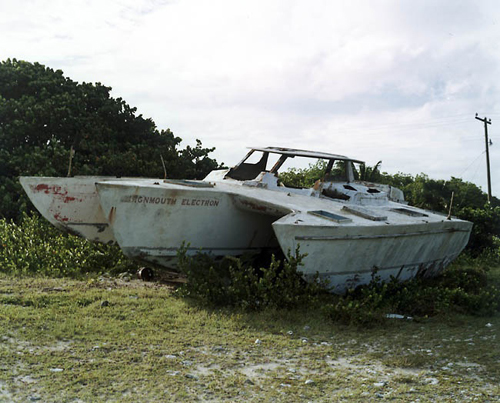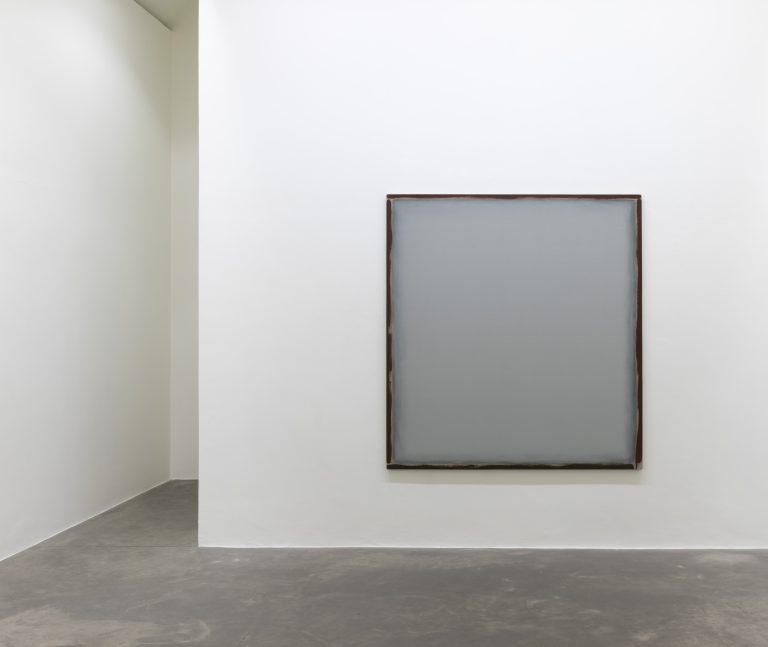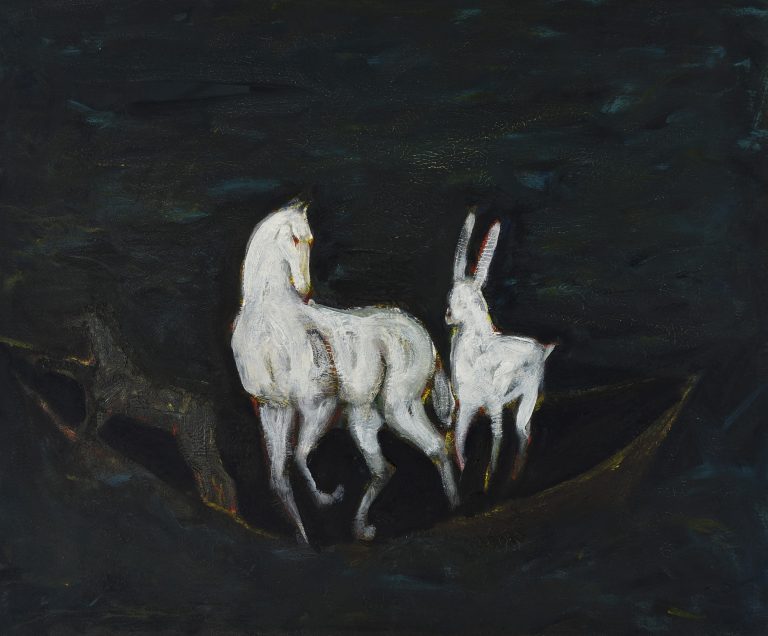Tacita Dean works in a variety of mediums including 16mm film, photography, drawing and painting. Her work occupies a space between the moving and the still image, playing with notions of time as a linear progression. Dean’s work itself operates in the space between reality and fiction, searching for something that could be considered elusive, and trying to preserve it in some way. Time plays an important role in Dean’s work as she has the ability to slow it down, particularly in her 16mm films, where the viewer must pause to consider the work and absorb the stillness.
Dean’s 16mm film Delft Hydraulics (1996) shows the simulation of a wave by a machine as seen from a side view. This machine was previously used for testing marine erosion and is now used for wave simulations. What is so surprising about this machine is the way that ‘something one would expect to be elusive is contained within a huge tank.’ [1] The artificial natural event is separated from nature and from its natural environment – the sea is diminished to this repetitive, mechanical rhythm. Jean-Christophe Royoux, in an essay entitled ‘Cosmograms of the Present Tense’ states that the ‘ebb and flow cease to follow the rhythm of the universe or offer a metaphor of eternity, and are instead ruled by the autonomous rhythm dictated by the activation of the machine.’ [2] By imitating nature through mechanical means, it becomes something entirely artificial.
While Delft Hydraulics shows the simulation of a natural event, other works by Dean reveal apparent supernatural effects produced by nature. Totality (2000), films the rare event of a total eclipse beneath a thick layer of cloud. The eclipse occurs when the moon completely covers the sun’s rays. When the light from the sun is covered for two minutes in the film, the empty screen reveals this totality. The artist Jeremy Millar stated that watching Totality is like ‘witnessing light at the creation […] a sense of being both in and out of time.’[3] Dean attempts to capture that which cannot be seen by the naked eye but through the assistance of a camera – a mechanical object. Totality verifies this absence as truth, as an image worthy of documentation. The two minutes of blackness and the silence of the film seems to slow down time, if only for a brief moment, and open up the possibility of a different reality or space to exist.
Her 1998 film, Tiegmouth Electron, focuses on the story of Donald Crowhurst and his fateful journey at sea. The ruined boat in the film is abandoned on the Caribbean Island of Cayman Brac. A series of still shots of the boat reveals the years of neglect and decay. In contrast to the boat, the white sand and turquoise ocean are seen behind. The stillness of the boat is like that of a dead corpse washed ashore. The movement of the sea further emphasize the onset of decay and the relentless passage of time.
In photography, Roland Barthes considers the preservation of life as the production of death. While the photograph claims to bear witness to the past and renounces death, it is, ironically, something that eventually fades. Similarly, Dean’s film Tiegmouth Electron, shows a fragment of past memory that becomes something different, something transformed. The film is used as an instrument that re-animates. By ‘duplicating an unprocessed fragment of reality […] it gives new life to dead objects and situations using techniques – like 16mm film- that are themselves almost a thing of the past.’ [4]
Dean’s film titled Boots (2003), is shot in a setting of an old house, the Casa Serralves in Porto. Three twenty minute films are shot, each in a different language and shown simultaneously. Boots is a man who walks around the house creating a narrative for each empty space. He floats in and out of each scene, like a ghost who seems to be part of the antiquated space. The house itself, absent of life, is made up of large empty rooms. It is like an artifical set, waiting for the play to begin. Through the lens of the camera, the image of the house is distorted and manipulated. The scale of the house fluctuates in size- sometimes looking like a huge Egyptian temple before shrinking to the size of a dollhouse when Boots comes towering through it. [5] As viewers, we experience uneasiness in the changing perspective and size of the house. Boots seems to be part of this unreliable narrative, misleading the viewer through the broken and abandoned architecture. While the films previously discussed seem to create an invisible presence through the absence of people, Boots is very much present.

Tacita Dean
Boots, 2003; (Still)
16mm colour film
Image held here
Roland Barthes describes history as a ‘memory fabricated.’ [6] Just as history offers established truths and concrete facts, we must be aware that photography, and film also represent a particular perspective on the external world, which may or may not mirror the truth. Dean’s films offer ambiguous reflections on the past and present creating an aura of uncertainty. Access to the house is mediated through Dean’s lens and also through Boots as he wanders in and out of the frame. The distorted view of the house and the character of Boots heightens our awareness of the scene and forces the viewer to question the truth of the unfolding narrative. The film seems to have the quality of a documentary as Dean appears to step back and allow these things to unfold naturally.
Germaine Greer writes that in every sequence, Dean’s camera is ‘locked off, prevented from tracking or zooming, from changing focus of aperture.’ [7] Dean offers no concrete meanings or answers. We cannot be certain if Boots is telling the truth or if he is manipulating the viewer and inventing the story. By showing the film with three screens, the repetition complicates the narrative. Who is the real Boots? The triple film creates a dream-like effect as Boots not only moves from room to room, but also from screen to screen across the gallery walls. He becomes like a ghost weaving in and out of the story, caught somewhere between the tangible and the ephemeral.
Dean’s work constantly seeks connections between past and present – fact and fiction. Landscapes and architectural spaces are not only presented from an objective view of the world, but are layered with inner, private spaces. Her 16mm films are haunting, lyrical and compelling to watch.
Notes
[1] Royoux, Jean-Christophe Royoux (2006), ‘Cosmograms of the Present Tense’ in Tacita Dean, Phaidon Press, London, p. 58.
[2] Ibid.
[3] Royoux, Jean-Christophe Royoux (2006), ‘Cosmograms of the Present Tense’ in Tacita Dean, Phaidon Press, London, p 59.
[4] Royoux, Jean-Christophe Royoux (2006), ‘Cosmograms of the Present Tense’ in Tacita Dean, Phaidon Press, London, p 62.
[5] Greer, Germaine (2006), ‘Focus’ in Tacita Dean, Phaidon Press, London, p 107.
[6] Berger, John (1977), Ways of Seeing, Penguin Books, London, p 253.
[7] Greer, Germaine (2006), ‘Focus’ in Tacita Dean, Phaidon Press, London, p 108.
Niamh Dunphy lives and works in Dublin.




